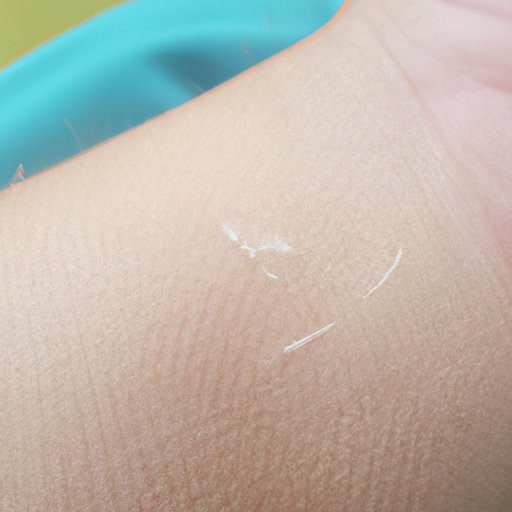Introduction
When it comes to cuts, there is often confusion about when a cut requires stitches. A cut that requires stitches is any cut that goes through the skin and causes significant bleeding or deeper tissue damage. Depending on the severity of the cut, stitches may be needed to close the wound and reduce the risk of infection. In this article, we will explore how deep a cut needs to be for stitches, as well as the different factors that determine the severity of a cut requiring stitches.
Explaining the Different Levels of Severity for Cuts Requiring Stitches
It is important to first understand how to assess the severity of a cut. Cuts that are less than 1/4 inch (6mm) deep typically do not require stitches. However, deeper cuts that are more than 1/4 inch (6mm) deep may require stitches depending on the type and location of the cut. Types of cuts that would require stitches include jagged or irregularly shaped cuts, cuts that are located near a joint, cuts that expose tendons or bone, and cuts that bleed profusely.

Examining the Factors That Determine How Deep a Cut Needs to be for Stitches
When determining whether or not a cut requires stitches, there are several factors that need to be considered. The first factor is the location of the cut. Cuts that are located near a joint, such as the elbow or knee, can easily gape open when the joint is moved and may require stitches to keep the wound closed. Cuts that are located on the face or scalp may also require stitches due to the increased risk of scarring.
The second factor is the depth of the cut. Cuts that are less than 1/4 inch (6mm) deep typically do not require stitches, but deeper cuts that are more than 1/4 inch (6mm) deep may require stitches. The third factor is the size of the cut. Cuts that are larger than 1 inch (2.5cm) may require stitches to ensure that the wound stays closed and heals properly.

An Overview of Medical Guidelines for Deciding Whether or Not a Cut Requires Stitches
In general, if a cut is deep, wide, or located in an area where it could easily gape open, then it may need to be stitched. If the cut is shallow, small, and located away from a joint, then it may not need to be stitched. It is always best to seek medical attention for any cut that is deep or large enough to require stitches. A doctor or nurse will be able to assess the wound and determine if stitches are necessary.
If stitches are needed, the type of stitches used will depend on the severity of the cut. Hand-sewn stitches, which are done with a needle and thread, are typically used for smaller, shallow cuts. Machine-sewn stitches, which are done with a special machine, are usually used for larger, deeper cuts. Both types of stitches are designed to close the wound and help it heal.
A Comparison of Hand-Sewn vs. Machine-Sewn Stitches on Deep Cuts
Hand-sewn stitches have several advantages over machine-sewn stitches. Hand-sewn stitches are less likely to cause scarring and can be removed more easily if needed. They are also less expensive and can be done quickly. However, hand-sewn stitches are not as strong as machine-sewn stitches and may not hold the wound closed as well.
Machine-sewn stitches have several advantages over hand-sewn stitches. Machine-sewn stitches are stronger and better able to hold the wound closed. They are also less likely to tear or come loose, and they can be done faster than hand-sewn stitches. However, machine-sewn stitches may leave a larger scar and can be more difficult to remove.

Describing the Healing Process After Receiving Stitches for a Deep Cut
Once the wound has been stitched, proper care must be taken to ensure that the wound heals properly. It is important to keep the wound clean and covered with a bandage to prevent infection. The stitches should be kept dry and should not be pulled or tugged on. The stitches will need to be removed by a doctor or nurse after the wound has healed, which typically takes 5-7 days.
Investigating the Long-Term Effects of Deep Cuts That Receive Stitches
After a deep cut has been stitched, there may be some long-term effects. Scarring is one of the most common long-term effects of a deep cut that has been stitched. The amount of scarring will depend on the type and location of the cut, as well as the type of stitches used. Infection is also a potential long-term effect of a deep cut that has been stitched. Proper care of the wound is essential to reduce the risk of infection.
Conclusion
In conclusion, it is important to understand how deep a cut needs to be for stitches. Cuts that are less than 1/4 inch (6mm) deep typically do not require stitches, but deeper cuts that are more than 1/4 inch (6mm) deep may require stitches depending on the type and location of the cut. It is always best to seek medical attention for any cut that is deep or large enough to require stitches. After the wound has been stitched, proper care must be taken to ensure that the wound heals properly and to reduce the risk of infection and scarring.
Overall, understanding how deep a cut needs to be for stitches is important in order to ensure that the wound is treated properly and heals correctly. With the right care, most deep cuts that receive stitches will heal without any long-term effects.
(Note: Is this article not meeting your expectations? Do you have knowledge or insights to share? Unlock new opportunities and expand your reach by joining our authors team. Click Registration to join us and share your expertise with our readers.)
